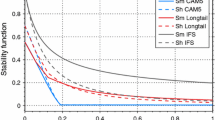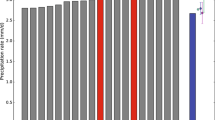Abstract
Using a multivariate model testing procedure that distinguishes between model inadequacies and data uncertainties, we investigate the ability of the LODYC GCM to simulate the evolution of the 20°C isotherm depth during the 1982–1984 FOCAL/SEQUAL experiment in the equatorial Atlantic. Two different versions of the model are considered: the “Ri” version which has a Richardson number dependent parameterization of vertical mixing and the new “TKE” version which uses a local estimation of the turbulent kinetic energy to parameterize vertical mixing. Some effects of the forcing uncertainties are considered by forcing the TKE version with three equally plausible wind stress fields whose differences are consistent with the measurement and sampling errors, and the drag coefficient indeterminacy. The resulting uncertainties in the model response are substantial and can be as large as the differences between simulations with the two GCM versions, which stresses the need to take the forcing uncertainties into account. Although only one Ri run is available, it is shown that the “TKE” parameterization significantly improves the representation of the equatorial upwelling and the simulation of the depth of the thermocline in the eastern Atlantic. However, there remain significant differences with the observations which cannot be explained by the forcing uncertainties that were considered. The two model versions perform better in the equatorial wave guide than in the 12°N-12°S domain, and they are better distinguished over large domains than along sections, which shows that a global multivariate view point must be used in model-reality comparisons. Finally, a comparison with a linear multimode model emphasizes the need for greater model complexity to properly simulate the equatorial upwelling and the thermocline variability in the tropical Atlantic.
Similar content being viewed by others
References
Blanke B, Delecluse P (1992) Low frequency variability of the tropical Atlantic ocean simulated by a general circulation model with mixed layer physics. J Phys Oceanogr 23:1363–1388
Braconnot P (1992) Validation objective de modèles d'océans tropicaux a l'aide des données FOCAL/SEQUAL. Thèse de doctorat, Université Pierre de Marie Curie, Paris
Braconnot P, Frankignoul C (1992) Testing model simulations of the thermocline depth variability in the tropical Atlantic from 1982 through 1984. J Phys Oceanogr 23:626–647
Cane MA (1984) Modeling sea level during El Nino. J Phys Oceanogr 14:1864–1874
Duchêne C, Frankignoul C (1991) Seasonal variations of surface dynamic topography in the tropical Atlantic: observational uncertainties and model testing. J Marine Resea 49:223–247
Eriksen CC, Katz EJ (1987) Equatorial dynamics. Rev Geophys 25:217–226
Esbensen SK, Kushnir Y (1981) The heat budget of the Global, ocean: an Atlas based on estimates from marine surface observations. Climatic Research Institution, Rep 29, Oregon State University, Corvallis USA
Flury BN (1989) Common principal components and related multivariate models. Wiley, New York
Frankignoul C (1991) Oceanic model testing. Proceedings, Aha Huliko'a, Hawaiian Winter Workshop, Honolulu, Hawaii. Müller P, Henderson D (eds) pp 387–397
Frankignoul C, Duchene C, Cane M (1989) A statistical approach to testing equatorial ocean models with observed data. J Phys Oceanogr 19:1191–1208
Hénin C, Hisard P (1987) The north equatorial countercurrent observed during the programme francais ocean climate dans l'atlantique equatorial experiment in the Atlantic ocean, July 1982 to August 1984. J Geophys Res 92:3751–3758
Houghton RW (1989) Influence of local and remote wind forcing in the Gulf of Guinea. J Geophys Res 94:4816–4828
Houghton RW, Colin C (1986) Thermal structure along 4°W in the Gulf of Guinea during 1983–1984. J Geophys Res 91:11727–11739
Large WG, Pond S (1981) Open ocean momentum flux measurements in moderate to strong winds. J Phys Oceanogr 11:324–336
Johnson NL, Kotz S (1970) Distributions in statistics, tomes 1 and 2. Wiley, New York
Levitus S (1982) Climatological atlas of the world ocean. NOAA Prof Pap 13:173. US Government Printing Office, Washington, DC
Lui WT, Katsaros KB, Businger JA (1979) Bulk parameterization of air-sea exchanges of heat and water vapor including the molecular constraints at the interface. Atmos Sci 36:1722–1735
Philander SGH, Hurlin WJ, Pacanowski RC (1987) Initial conditions for a general circulation model of tropical oceans. J Phys Oceanogr 17:147–157
Reverdin G, Delecluse P, Levi C, Morlière A, Verstraete JM (1991) The near surface tropical Atlantic in 1982–1984. Results from a numerical simulation and data analysis. Prog Oceanogr 27:273–340
Smith SD (1988) Coefficient for sea surface wind stress, heat fluxes and wind profiles as a function of wind speed and temperature. J Geophys Res 93:15467–15472
Weisberg RH, Colin C (1986) Equatorial Atlantic ocean temperature and currents variations during 1983 and 1984. Nature 322:240–243
Weisberg RH, Tang T (1990) A linear analysis of equatorial Atlantic ocean thermocline variability. J Phys Oceanogr 20:1813–1827
Wu J (1986) Stability parameters and wind stress coefficient under various atmospheric conditions. J Atmos Oceanic Technol 3:333–339
Author information
Authors and Affiliations
Rights and permissions
About this article
Cite this article
Braconnot, P., Frankignoul, C. On the ability of the LODYC GCM to simulate the thermocline depth in the equatorial Atlantic. Climate Dynamics 9, 221–234 (1994). https://doi.org/10.1007/BF00208254
Received:
Accepted:
Issue Date:
DOI: https://doi.org/10.1007/BF00208254




